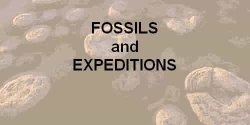Fossil Basics
Fossil Basics - under development...
source http://nmnh.typepad.com/100years/2013/09/excuse-me-is-this-a-fossil.htmlhttps://www.geolsoc.org.uk/en/Education%20and%20Careers/Resources/Field%20Work%20Resources
http://www.fossilmuseum.net/fossil-art
http://austhrutime.com/journey.htm
http://science.nationalgeographic.com/science/photos/permian-period/#/dimetrodon_921_600x450.jpg
How do you know it is a fossil - characteristics of
once living things vs. non-living things
Finding fossils
- Where to Find Fossils
- Looking in Creeks and Stream Beds
- Fossils and the Age of the Rocks - Geological
Periods
- Quaternary(old)
- Neogene(new)
- Paleogene(new)
- Tertiary(old)
- Cretaceous
- Jurassic
- Triassic
- Permian
- Carboniferous
- Devonian
- Silurian / Ordovician
- Cambrian
- Precambrian
- Comparing your fossils to Index Fossils within
a Period
Excavating fossils
- Quaternary(old)
- Neogene(new)
- Paleogene(new)
- Tertiary(old)
- Cretaceous
- Jurassic
- Triassic
- Permian
- Carboniferous
- Devonian
- Silurian / Ordovician
- Cambrian
- Precambrian
Preparation of Fossils
Every fossil has a story to tell
Tracks and Dinosaurs
Donating fossils to Museums and Universities
see
also Living Fossils...
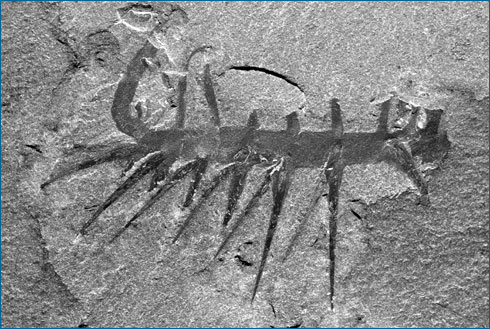
Cambrian fossil over 500 million years old - weird! - but clearly a living thing!
How do you know it is a fossil - characteristics of once living things vs. non-living things
How do you know something is a fossil?
Years of practice helps but here are three basic guidelines....
1. Color
The fossil trilobites below are a a different color than the surrounding khaki rocks.
This because fossils usually consist of the hardest and most durable remains of an ancient creature. It is a different material that falls into the unconsolidated sediment so it has a different colour.
Afterwards, what once might have been bone or shell is often replaced cell by cell with rock (often the mineral calcite)
So for example fossil bone (now rock) is denser than weathered modern bone.
Fossils may be lighter than the rocky substrate, or they might be darker – it all comes down to the weathering process, and the fossil materials.
Plant fossils are almost always darker than the rock in which they’re found probably because they originally contained carbon.
Alternatively, microfossils on the ground, tend to be a lighter, almost creamy color since they have been exposed to the elements—though teeth, claws, and scales are dark and glossy.
110Myo schleral (eye support) ring of an ichtthyosaur is a different colour than the host rock
2. Texture
Fossils have textures that remind us of the textures in living things. A piece of fossil turtle shell has a distinct, dimpled texture, which makes it noticeable even though it’s only about 4 cm wide.
Some bone patterns can tell you who the original owner might have been. Turtle shells have little pits and grooves on one side. Young and old members of the same species differ in the growth patterns on their bones, a fact which can help scientists determine the biological age of a fossil. Sometimes bones even have little marks on them where muscles used to be attached.
texture of a 4.2Myo turtle shell is similar to a modern turtle, pointer shows tooth mark of a crocodile attack
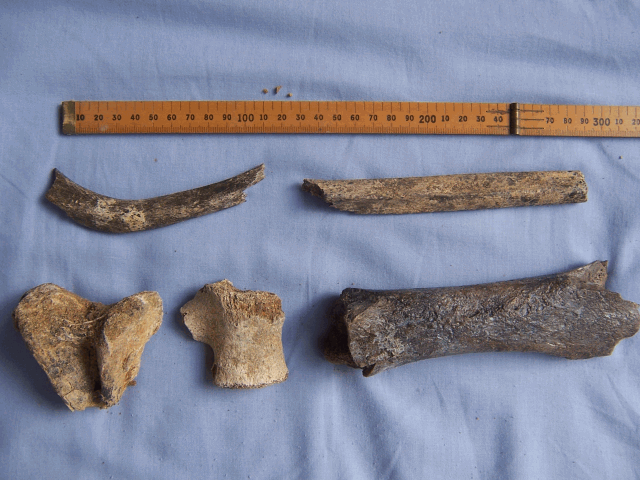
fossil bones with porous textures
Bones are more porous than rock, and this texture difference makes them easier to spot. Because of its “spongy” texture, if you touch a fossil to your tongue it will typically stick, whereas rock and soil won’t. If you’re not in the mood to do the tongue test, you can also look for pores through a hand lens.
3. Shape
If you’re lucky, the item’s shape will be an even bigger clue. While many bone fragments are unidentifiable, there are many bones that are highly diagnostic for an entire group of animals, if not for a species. These diagnostic bones tend to be things with complex shapes, like vertebrae, skull bones, and even teeth and claws. For plants, the diagnostic features tend to be the leaf edges and bases, as well as the pattern of veins.
Fossils come in a wide variety of shapes, but they pretty well all have shapes that remind us of shapes in living things. Living things repeat patterns but each repetition though slightly different can be modeled on a computer using mathematics called chaos theory.
Distinctive bones aren’t the only fossils with easily identifiable shapes. Coprolites (fossil poop) look the way you’d expect them to, and tend to be a little bit lighter than the rocks around them. Casts, molds, and steinkerns (internal molds) look like the original organism; mollusks and other animals with shells are often preserved this way. If you spend even a short time looking for fossils, you’ll learn how to tell that the thing in your hand is a vertebra or a root. But to know what genus it belongs to, you’ll have to spend some time handling fossils and doing research. Generations of scientists have taken the time to describe in detail the anatomy of animals past and present, and you can compare your fossils to these descriptions.
fossil poo (called a coprolite) looks like modern poo but everything soft is replaced by rock
Pseudofossils
Some things look a lot like fossils but are not. We call them pseudo-fossils (pseudo means fake).
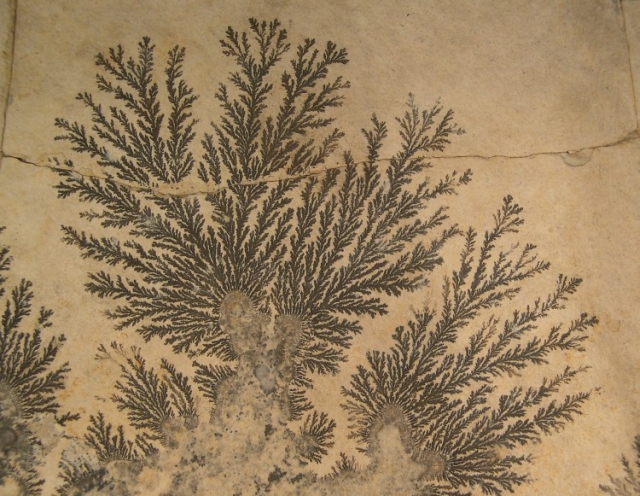
"fern-like" manganese crystals on a rock surface are not a fossil
Some fossils are the actual creature for example an insect in a piece of amber (fossilised tree sap) is still the original insect!
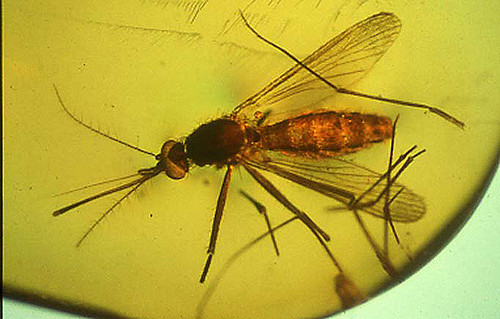
original text by Juliana Olsson, NMNH Office of Exhibits Writer with the support of Angela Roberts and Siobhan Starrs - abridged by Earth Science Australia
Finding Fossils
Fossils are found in sedimentary rocks most of the time.Sometimes fossils can be found under volcanic ash or even preserved under a lava flow, but this is very rare.
NOTE: Sedimentary rocks do not always have fossils in them.
Layers are a characteristic of sedimentary rocks. The bottom layers are naturally the oldest.
Some types of rocks found in the layers:
Limestone, mainly calcium carbonate, common in warm, shallow seas, often has fossils.
Shale is a fine grained rock formed from silt and clays. It preserves fossils well.
Sandstone is widespread in desert deposits and on shallow water sediments.
Ripple marks and Mud cracks are characteristics of many sedimentary rocks formed in shallow waters. Ripple marks are common in shale. Mud cracks are form when mud drys quickly. These imply the presence of sunlight, water and moderate temperature conditions related to the possibilities of life.
Where to look...
Sedimentary is your best bet for finding something. Too find some where that has fossils is quite hard if you don't already know where a site is. If you don't know where a site is you could ask the local Rock Club or a Museum. You could also look in freshly exposed rock, like look in road or railway cut. Visit mine dumps quarries and places where rocks are being excavated for new construction. Cliffs, river banks, headlands and other naturally exposures are also good. Remember that all these places have an element of danger. Watch for traffic at road cuts and get permission before entering quarries.
Looking in Creek Beds and Streams...
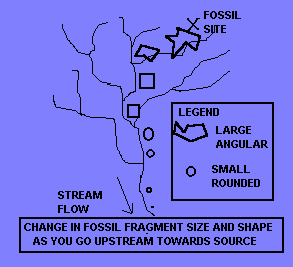
1.Start at the bottom of the creek
2.Look for fragments of bone
3.Follow them up the creek looking for larger, more angular bits as you go
4.When the bits of bone stop. Look up on the banks for the fossils
5.Find the larger piece of bone and excavate it
The age of the rock is important - Geological Time Periods
Generally speaking the Age of the Rocks gives you a good idea you what kinds of fossils you are likely to find
The time periods are very important to a fossil hunter (palaeontologist).
The table below is a very simple Geological Time Line. These are the older traditional Geological Periods.
Click on a geological period below to take you to a description of life on earth at that time...
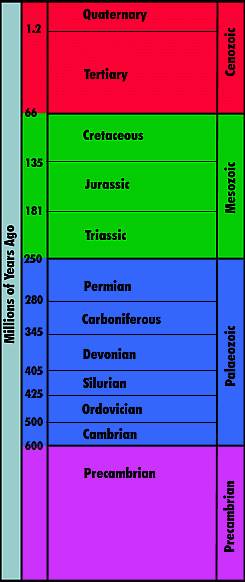
More detailed Geological Timetable from GSA (116Kb)
Very large Geological Timetable (1.55Mb)
The newer Geological periods are shown in the table below...Click on a Period to take you to a description of life on earth at that time...
|
Era
|
Traditional Periods
|
New Periods
|
Epochs
|
|
Cenozoic |
Holocene Epoch
|
||
|
Pleistocene Epoch
|
|||
|
Pliocene Epoch
|
|||
|
Miocene Epoch
|
|||
|
Oligocene Epoch
|
|||
|
Eocene Epoch
|
|||
|
Paleocene Epoch
|
Quaternary Period
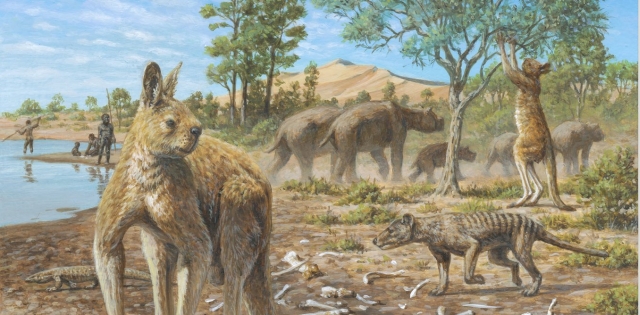
The Quaternary Period is a geologic time period that encompasses the most recent 2.6 million years — including the present day.
Part of the Cenozoic Era, the period is usually divided into two epochs — the Pleistocene Epoch, which lasted from approximately 2 million years ago to about 12,000 years ago, and the Holocene Epoch, which began about 12,000 years ago.
The Quaternary Period has involved dramatic climate changes, which affected food resources and brought about the extinction of many species. The period also saw the rise of a new predator: man.The Quaternary Period: A Time Of Giant Mammals or Megafauna The Pleistocene is known for its megafauna or “giant mammals.” Along with the wooly mammoth and wooly rhinoceros there were other giants: bison, ground sloths, and deer. There were giant carnivores as well. The saber tooth tiger, cave bear, and dire wolf were bigger than their modern counterparts. The megafauna disappeared at the end of the Pleistocene. All that remains are a few species of smaller, though still good-sized, animals in Africa: the elephant, hippopotamus, and rhinoceros. The Rise of Humans For us, the most important development of the Quaternary Period is the development of the hominids: Humans. From the first primates in the Tertiary Period to modern man, the hominid species has evolved amazing abilities. The earliest hominid fossils found so far date from the late Tertiary Period. They were found in Africa. As the Pleistocene Epoch continued, hominids spread throughout the world. Their larger brains allowed a level of thought and feeling that was, and is, unique among the animals. We think and solve. We change and control. The future of our planet will be greatly affected by the Age of Humans.
Neogene Period
During the course of the Neogene period, life on earth adapted to new ecological niches opened up by global cooling--and some mammals, birds and reptiles evolved to truly impressive sizes in the process. The Neogene is the second period of the Cenozoic Era (65 million years ago to the present), preceded by the Paleogene period (65-23 million years ago) and succeeded by the Quaternary period---and is itself comprised of the Miocene (23-5 million years ago) and Pliocene (5-2.6 million years ago) epochs. the Neogene period the golden age of open prairies and savannahs. These extensive grasslands spurred the evolution of even- and odd-toed ungulates, including prehistoric horses and camels (especially in North America), as well as deer, pigs and rhinoceroses. During the later Neogene, the interconnections between Eurasia, Africa, and North and South America set the stage for a confusing network of species interchanges, resulting (for example) in the near extinction of South America's Australia-like megafauna. From a human perspective, the most important development of the Neogene period was the evolution of apes and hominids.There were two major trends in plant life during the Neogene period. First, plunging global temperatures spurred the rise of massive deciduous forests, which replaced jungles and rain forests in high northern and southern latitudes. Second, the worldwide spread of grasses went hand-in-hand with the evolution of mammalian herbivores, culminating in today's familiar horses, cows, sheep, deer, and other grazing and ruminant animals.
Paleogene Period
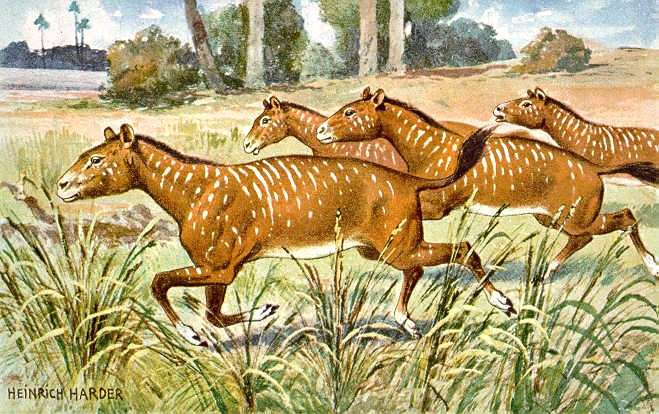
Mammals began a rapid diversification during this period. After the Cretaceous–Paleogene extinction event, which saw the demise of the non-avian dinosaurs, mammals transformed from a few small and generalized forms that began to evolve into most of the modern varieties we see today. Some of these mammals would evolve into large forms that would dominate the land, while others would become capable of living in marine, specialized terrestrial, and airborne environments. Those that took to the oceans became modern cetaceans, while those that took to the trees became primates, the group to which humans belong. Birds, which were already well established by the end of the Cretaceous, also experienced an adaptive radiation as they took over the skies left empty by the now extinct Pterosaurs. In comparison to birds and mammals, most other branches of life remained relatively unchanged during this period. As the Earth cooled, tropical plants became less numerous and were now restricted to equatorial regions. Deciduous plants, which could survive through the seasonal climates the world was now experiencing, became more common.
Tertiary Period
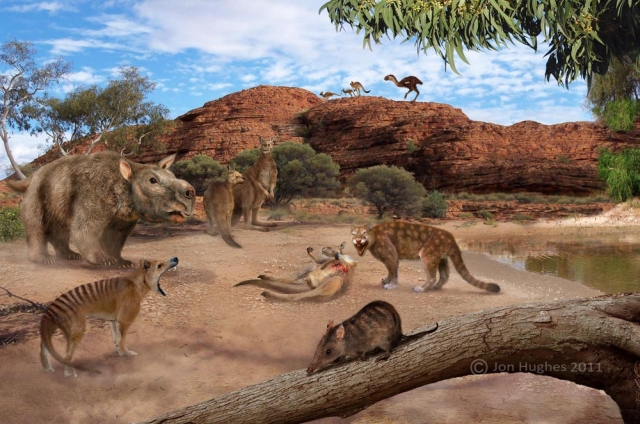
This Era started 65 million years ago and finished 2 million years ago.
This Era is split into 5 parts.
This was the Era of mammals.
Life in the Tertiary Era On land, the age of the mammals was beginning. Rodents evolved, as well as gliding mammals and the early primates. Sharks and fish took over from marine reptiles. Towards the middle of this Era, the ancestors of elephants, horses, cattle, pigs, rhinos and deer appeared. Other mammals such as whales and sea cows took to the water. Other groups of animals were also evolving, including ants and bees, starlings and penguins, moles, camels, cats, dogs and bears. Towards the end of this period , grazing hoofed animals spread and diversified. The ancestors of humans appeared in Africa.
Plant life in the Tertiary Era In the early parts of this era, flowering plants continued to spread and diversify. Towards the end of this era the climate cooled, grasslands took over from the forest
Cretaceous Period
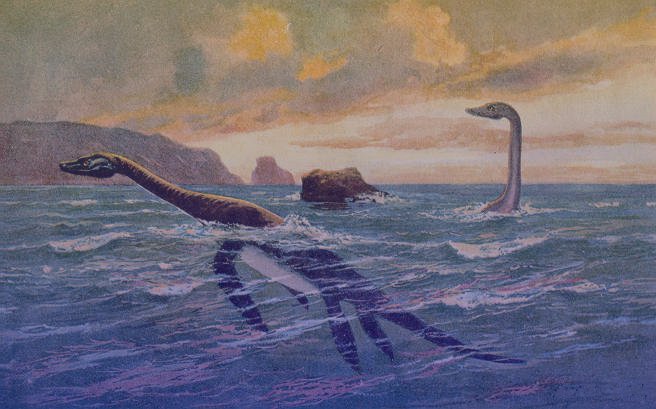
Started 144 million years ago and lasted to 65 million years ago. This was the period of the explosion of flowers.
The explosion of flowers Up until the beginning of the Cretaceous Period, the distribution of spores and pollen was a risky business. In the Cretaceous Period new and more effective ways of spreading pollen developed. Flowering plants were now evolving with a partnership with the insects.
Life in the Cretaceous Period Giant turtles and marine reptiles dominated the oceans. On land snakes evolved. There were new kind of dinosaurs. Insects such as moths and butterflies, got there food from the new flowers. At the end of the period, there was a mass extinction which saw ammonites, ichthyosaurs, and many other marine groups to disappear and the dinosaurs became extinct. Plant life in the Cretaceous Period The following plants appeared and evolved relationships with insects for pollination. The flowers spread rapidly over the land.
Jurassic Period
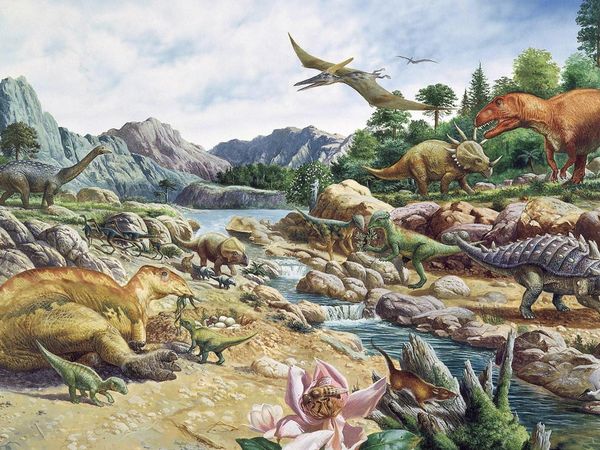
The Jurassic period started 213 million years ago and lasted until 240 million years ago. This was the first period to have birds.
Life in the Jurassic Period Turtles and crocodiles increased in numbers and variety. New species of plesiosaur and ichthyosaur arose. On land insects were thriving including ancestors of modern ants, bees, earwigs, flies and wasps. The first bird appeared. Dinosaurs ruled the land.
Plant Life in the Jurassic Period Plants spread across the land as the climate became wetter. The of the modern cypresses, pines and redwoods appeared in the forests.
Triassic Period
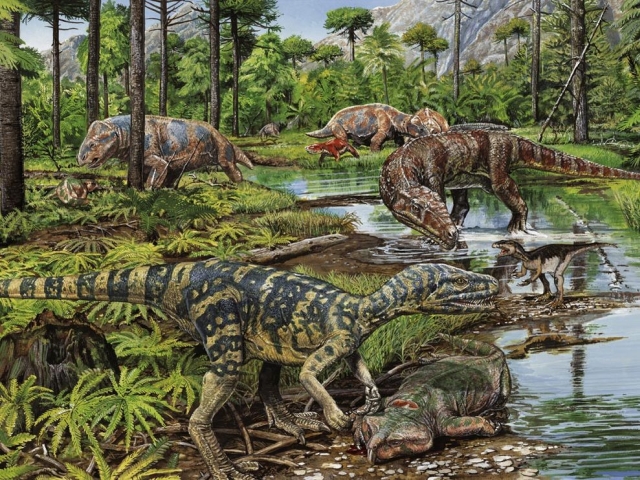
This period started 248 million years ago and finished 213 million years. This period was the beginning of the Mesozoic era.
Life in the Triassic Period Dinosaurs and other reptiles became the dominate land animals. Frogs appeared and later the first tortoises, turtles and crocodiles. The first mammals appeared.
Plant Life in the Triassic Period The cone-bearing plants diversified forming forests of cycads, monkey-puzzle trees, ginkgoes and conifers.
Permian Period
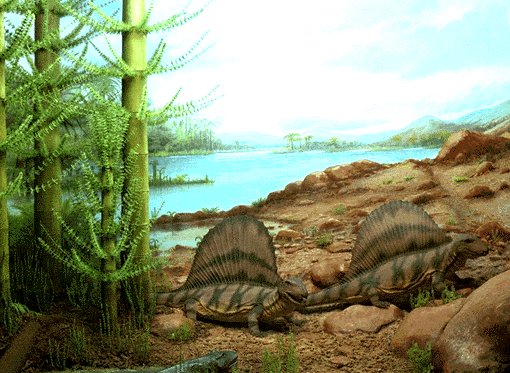
This period started 286 million years ago and went to 248 million years ago. This period was the period which reptiles took over.
Life in the Permian Period
Ammonities were still very abundant. Modern corals began to take over the early reefs. In the early part of this period amphibians dominated fresh water. Aquatic reptiles evolved. Towards the end of this period over 50% of the animal families disappeared, including many amphibians, ammonities and trilobites. Reptiles took over from amphibians on land.
Plant Life in the Permian Period
Conifers appeared and spread inland and up mountains. The southern land mass was dominated by forests of large seeding ferns.
Carboniferous Period
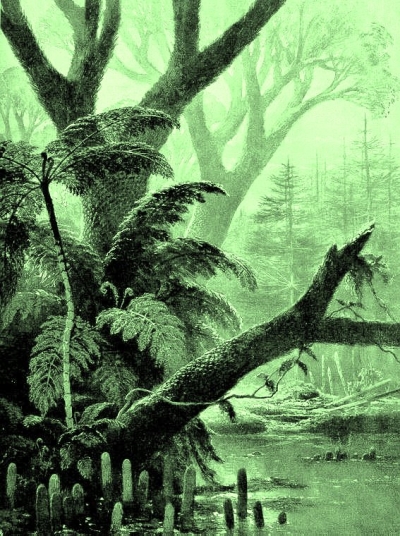
This period went from 360 million years ago to 286 million years ago. During this period insects were everyware and the decaying trees during this time produced the coal known today
Life in the Carboniferous Period Ammonites and Brachiopods became more abundant. The age of amphibians appeared. Insects including grasshoppers, cockroaches, silverfish, termites, beatles and giant dragonflies also evolved. In the late part of this period the first reptiles appeared. Plant Life in the Carboniferous Period Dence forests of giant clubmosses, horsetails, tree ferns and sead plants up to 45m tall. The undecomposed remains of these forests develop into coal.
Devonian Period
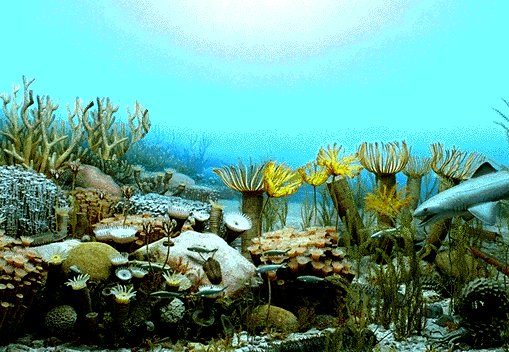
The Devonian period started at about 410 million years ago and ended about 375 million years ago. This period was the age of the fish.
Life in the Devonian Period During this period there was a rapid evolution of fish, including sharks and rays, lobe finned fish and ray finned fish. Ammonities increased in population. Giant squid up to two meters long hunted the seas. Many arthropods including spiders and wingless insects invaded the land. Plant Life in the Devonian Period Plants spread from the margins of the water to cover large areas of land in dense forest. Some trees developing up to 38m high.
Silurian/Ordovician Periods
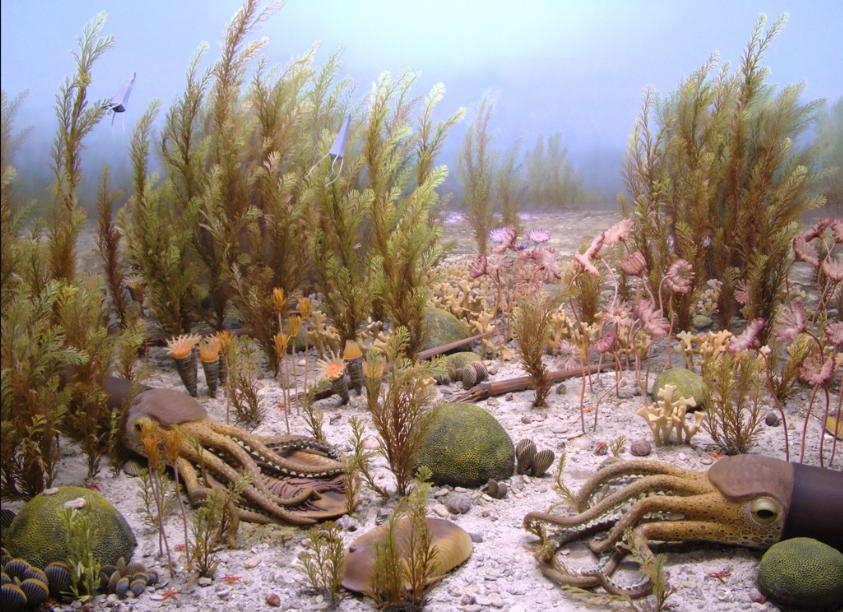
These time periods from 500 million years ago to 435 million years ago. In these periods powerful predators and reefs began to be built.
Life in the Ordovician and Siluran Periods
In these periods there was a great increase in filter feading animals. These included sea mats, sea lilies, brachiopods, molluscs and graptolites which all met their peak in the Ordovician period. Durying the Siluran period rugose corals were very active reef builders. This was the age of the great preditors including sea scorpions, and the first jawed fish. Brachiopods and trilobites thrived.
Plant life in the Ordovician and Siluran Periods
The first true plants first apeared in the late Ordovician period. In the Siluran period plant life surounded the margins around the water.
Cambrian Period
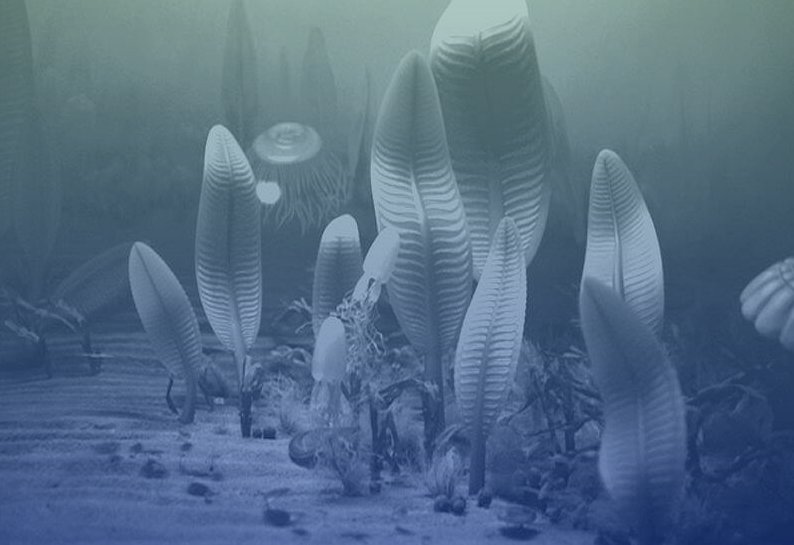
The Cambrian period began about 570 million years ago. It lasted for about 70 million years. The period began with an astonishing explosion of evolution, during which most of the major groups of animals we know today made their first appearances on Earth.
The Cambrian Explosion
The Cambrian explosion is one of the biggest mysteries in the history of life. It took 2.5 billion years for simple cells to become more complex cells. It took another 700 million years for multicellular creatures to appear. Then, in just 100 million years, came a tremendous variety of multicellular animals. For over 500 million years not a single new basic body plan was evolved.
The Cambrian period sea level rose and fell making some populations extinct. As the Cambrian period went on, animals evolved new and more specialized ways of feeding thus creating a greater variety of animals.
Life in the Cambrian Period
In the huge burst of evolution creatures including microscopic organisms, sponges, starfish, sea urchins, sea lilies and velvet worms all evolved in this period. The first shelled animals also appeared; trilobites and brachiopods who then dominated the seas. Later in the period molluscs and primitive fish evolved. Trilobites were a major step in the evolution because they had the first eyes.
Plant Life in the Cambrian Period
In the Cambrian seas the only plant life was primitive algae and seaweeds.
Precambrian Era
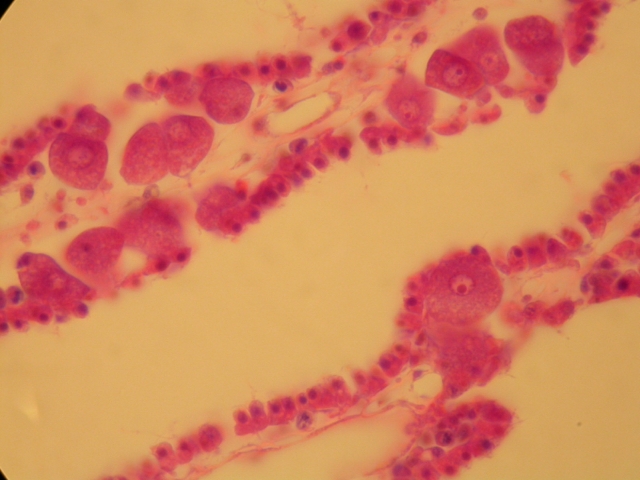
The Precambrian Period starts with the birth of Earth to the appearance of many-celled animals, about 570 million years ago.
Methane and other gases were the only gases in the Earth primitive atmosphere.
These gases dissolved into the masses of water which covered the Earth, forming a complex chemical "soup".
Lighting discharges on this soup acted in a way that caused the chemicals to react, forming more complex chemicals very similar to the ones in living cells.
After a few million years these chemicals developed the ability to reproduce. In the soup there was also fat globules.
If the soup was stirred violently by the wind, the complex chemicals may have become trapped within the fat globules.
In time these structures evolved into lining cells surrounded by fatty membranes.
Life in the Precambrian seas
Some of the first life in the sea was stromatolites, which appear to be made up of lots of rings of limestone, with organic layers in between.
Later life in these sea saw a range of soft body creatures, including jellyfish, worms and leaf like sea pens.
The only evidice left from that period where trace fossils left by the animal.
Comparing to Index Fossils
An index fossil is a fossil that is useful in working out the age of a bed of rock. You need several index fossils in combination to got a good date.A good index fossil needs:
- To be easy to identify
- Common
- Exists over a short geological time range
- Has worldwide distribution
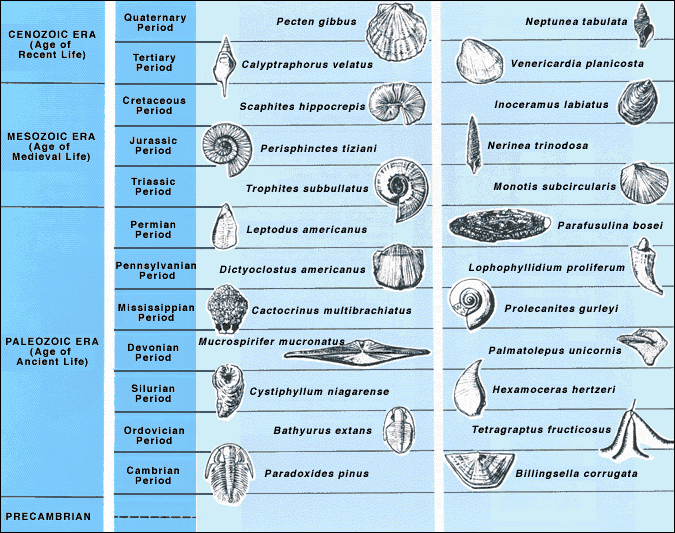
Index fossils in the first area determine the age in the second area.
A simple example shown below...
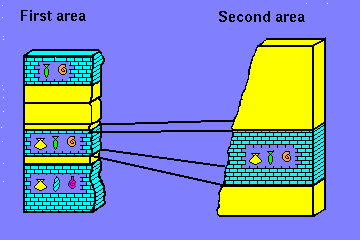
A more complex example shown below...
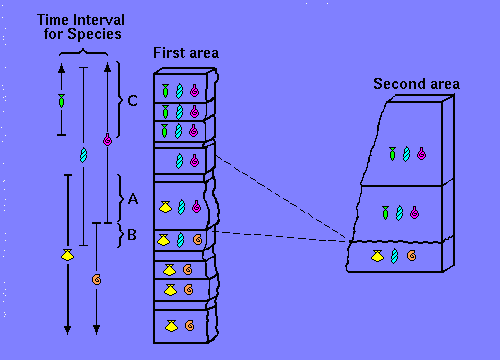
Excavating fossils - What to do once you find a fossil
Extracting Fossils from Stone
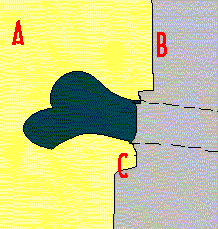
- Find the fossil and look at it, see which way the covered piece of the fossil is pointing
- Start cutting away at the top and at the sides of the fossil. With the large chisel when the fossil is well below were you are working, and then use the small chisel when you get closer to the fossil. Use the screwdriver and then the dental pick to get really close to the fossil. Use the paintbrush to make sure you can see what you are doing. While you are doing this cover the end of the fossil with some newspaper or something to protect it from falling pieces of rock. Keep digging until the whole topside of the fossil is visible. Put some wood glue on as soon as you have finished the topside.
- Start cutting away from the bottom, be very careful, as there may be something even better below!Do the same as the topside only starting below the fossil this time. Apply the wood glue then remove the fossil carefully putting it on some newspaper. Wrap the fossil tightly in the newspaper and put it in the packsack and keep it out of the sun.
- Take a good close look at the fossil make sure to note the location of all the pieces of fossil, so that later you can reassemble it in the correct order. Remember that fossils in sandstone are not always in good condition. Although they may be easer to get at they are much harder to get out in one piece.
- As a rule any fossil, in loose sand or rock, must be approached from the top. If you try excavating for the bottom the fossil will fall out. Before you start digging cover the fossils with some thing to protect them. Use the shovel first to get started then as you get closer to the fossil use the screwdriver and the paintbrush. For the really fine work use the dental pick. As soon as the fossil is completely visible cover it with the wood glue. The wood glue acts as the rock around the fossil after it has been removed from the rock. The glue prevents the fossil from expanding and cracking from the sudden drop in pressure and change in humidity and temperature. <
- A good pack sack to carry the removed fossil.
- Newspaper is used to wrap and protect the fossil after it has been removed.
- Note books and pens are a good thing to bring along, as you can make notes of were you found the fossil, it condition and its basic shape this can then be used later to give some information to help classify the fossil later. This white wood glue is great because it dissolves in water so if you need to reassemble or if you mess-up you can soak the fossil and try again!
- A hammer and a large and small cold chisel are used to remove fossils from the rock.
- A steel prying bar may come in handy.
- A screwdriver, dentist pick and a paintbrush can be used to do fine work and brush away dust from the site.
- Plaster may be handy if you want make a mould of the fossil.
- Aquadhere or similar white wood glue is good for protecting the fossil as it comes out of the rock. The glue holds all the little bits on the fossil. It should be the kind of glue that when you soak it in water it will soften again so if you get the pieces wrong the first time you can glue them together again. Test it before you use it in the fiels
- A map (detailed topographic or geological),gps, compass(do not rely on just one device to find your location), magnifying lens (5-10 power).
- first aid kit
- food
- plenty of water
- leave a plan of where you are going and when you will get back with a reliable person and let them know when you are done
- a phone or radio check each day is a good idea
- check weather forecast and keep an eye on the weather - get out early if the weather looks like it will go bad
In Sandstone
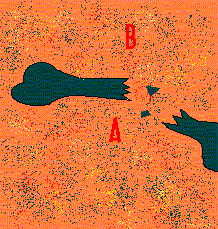
Basic Tools
The first thing you will need
before you excavate anything will be Tools and some basic essentials.
There are a few basic packs you should take for different environments.
If the fossils are in solid rock.
Safety
Preparation of Fossils
Once exposed n order to keep fossils from deteriorating hardeners and adhesives may be required. Hardeners hold fragile or friable fossil specimens together. They are particularly useful on consolidating poorly mineralized bone . A hardener or consolidant is a resin which has been dissolved in an easy to evaporate solvent such as ...water, acetone, alcohol, and toluene. You dissolve a pure resin in the solvent, let it soak into the fossil and then when the solvent evaporates the hardener is left behind and glues the fossil particles together. A common resin / solvent combination is dissolving polystyrene from plastic drink cup in acetone solvent. this mixture can be absorbed deep into the fossil matrix. Emulsions are also useful such as PVA (polyvinyl acetate) ie. white wood glue and water another readily available usefiul combination although its penetration into the fossil matrix is not as deep. The advantage of this mixture is that on further soaking in water the fossil parts can be dissassembled then re assembled - so it is useful in the field where quick consolidation on site can then be followed by an enhanced fitting of fossil fragments in a lab. It is important no to overdo preparation or use excessive hardeners as fossil details may be lost - minimal preparation is best.
Adhesives may be required to "glue" fossil parts together. Butvar, polyvinyl butyral is commonly used as it does not shrink and can be , with some difficulty be removed using a specific solvent. Acrylic polymers dissolved in common solvents such as acetone, ethyl alcohol, or carbon tetrachloride Epoxy resins,cyanoacrylate"superglues" are other candidates.
Every fossil has a story to tell
see our Story in a Rock webpage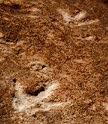
Tracks and Dinosaurs
Dinosaur's tracks can be used to find out some things on the dinosaurs behaviour.With footprints you can see a bit of the dinosaurs life style like if it is sitting down, walking, swimming or running.
You can find out how big the dinosaur was by the depth of the footprints.
Also you may be able to find out what family it comes from, for example Sauropods they are the dinosaurs that walk on 4 legs mostly larger then other dinosaurs. Theropods are bird-like, they walk mainly on 2 legs and eat meat.
Hadrosaurs are also bird-like, walk mainly on 2 legs but they eat plants.
Two legged Dinosaur
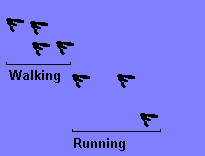
Walking
Tracks with short distances between footprints indicate dinosaurs at slow speeds.
Running
Tracks with longer distances between footprints indicate dinosaurs at faster speeds.
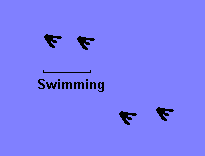
Swimming
Incomplete footprints suggest that the dinosaurs swam.
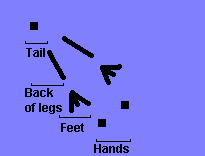
Sitting down
The dinosaurs in this position may have been resting, having a sleep or rolling in the mud to rid itself of parasites. This is a good example of their behaviour.
4 Legged Dinosaur
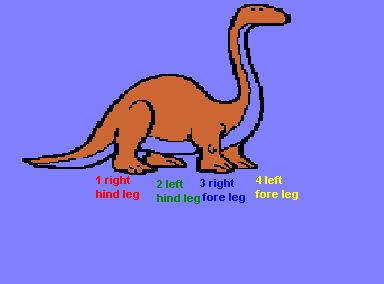

Walking
Tracks with short distances between footprints indicate dinosaurs at slow speeds. Slow walking 4 legged dinosaurs, such as Sauropods would leave a pattern of tracks as shown above.
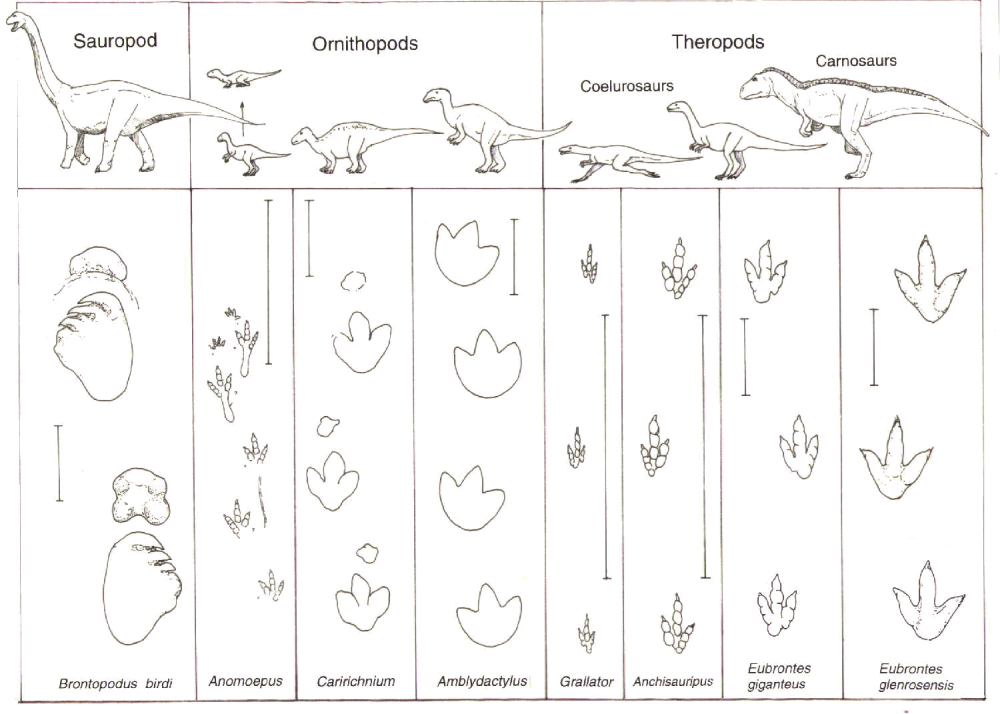
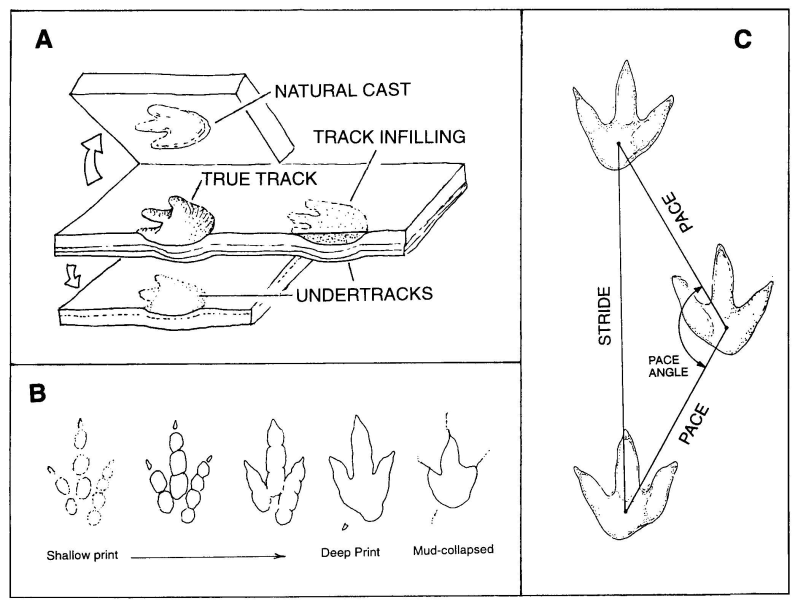
- Thyreophora (armored dinosaurs)
Scutellosaurus
Scelidosaurus
Stegosauria
Ankylosauria -
Marginocephalia, a group including:
Ceratopsia (horned dinosaurs)
Pachycephalosauria (bone-heads) - Ornithopoda, a group including:
Hadrosauridae ("duckbilled" dinosaurs)
Heterodontosaurus, the "different-tooth" dinosaur.
Hypsilophodontidae
Iguanodontidae - Sauropoda were large herbivores such as Apatosaurus and Diplodocus.
- Theropoda were bipedal carnivores (meat eaters), ranging from the chicken-sized Compsognathus and the fearsome Deinonychus and Velociraptor to the crested Dilophosaurus and the gigantic Tyrannosaurus. The oldest known dinosaurs, from the middle Triassic of South America, were saurischians.
- It is important that you check with the landowner or authority where you are fossil hunting.
- you should offer the landowner the fossils you find - it is their land or and/ or their permission to keep the fossils, often landholders are happy to do this but may impose some conditions on where you go and what you do
- you should explain what you are going to do with the fossils - landowners may be happier if you donate your finds to a local museum or university
- animals / birds may be having babies and should not be disturbed
- your presence may distress animals / birds for example... keep them away from a water hole
- the smoke from your camp fire may distress animals / birds them or the risk of accidental fire may be unacceptably high
- there may be new crops in the ground
- the land may have just been sprayed with herbicide or some other agricultural chemical and be dangerous to enter
- the farmer may be in the process of mustering or harvesting and may not want people on-site during this period for safety reasons
- your digging may erode stream banks and dirty down stream water sources - think before you act!
- You should consider what you will do with the fossils you find
- fossils are part of our ancient heritage.
- fossils give us interesting insights into the ancient past
- it would be best if this knowledge is available to all citizens
- you should show your finds the landowner at a time that is suitable to them
- the most responsible action is to donate your finds to local Museums or Universities - keep some photos / donate the fossils
- Don't be greedy or destructive, leave some fossils for others
- leave the fossil site in bewtter condition than you found it
- if you uncover good specimens you choose not to collect consider covering them back up so they are not exposed and damaged by the elements
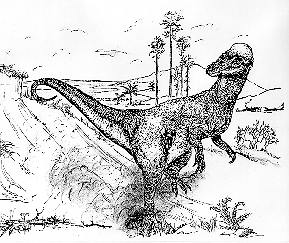
Dinosaurs are divided into two groups based on hip structure:
The Order Ornithischia and The Order Saurischia.
Ornithischian Dinosaurs
There were many kinds of ornithischian dinosaurs, dating back to the early Jurassic. The Ornithopoda included the hadrosaurs ("duck-billed dinosaurs"), the iguanodontids, the heterodontosaurs, the hypsilophodontids, and various other dinosaurs. The Ceratopsia included the horned dinosaurs, the Ankylosauria and Stegosauria (now usually grouped together in the Thyreophora) included various types of armored dinosaurs, and the Pachycephalosauria, the extremely thick-skulled pachycephalosaurs.
The Ornithischian dinosaurs had a hip structure similar to that of birds, but they were not the ancestors of birds. They outnumbered the Saurischians. The Ornithischians were vegetarian, and included two-legged, plated, armored, and horned dinosaurs.
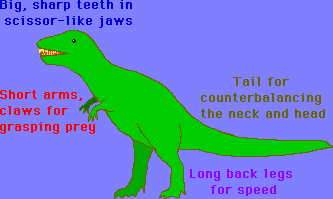
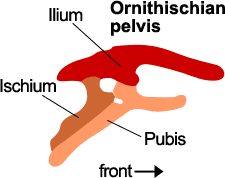
Sauroischian Dinosaurs
Certain features distinguish Saurischians (among other major characteristics; including a grasping hand, asymmetrical fingers, and a long, mobile neck) is the pubis that points downward and forward at an angle to the ischium.
The saurischians form two major groups.
The "bird-hipped" condition of a pubis pointing toward the back of the animal occured twice independently, once in the ornithischians and once in the lineage leading to birds, an example of convergent evolution.
Thus "ornithischia," taken literally, is a misnomer, since the ornithischians have ornithischian-like pelves, not bird-like.
Only birds (and their immediate ancestors) have bird-like pelves.
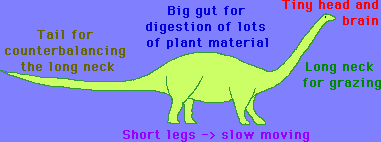
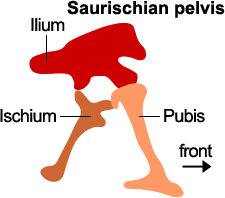
more small dinosaur images...
Donating fossils to Museums and Universities
Responsible Fossil Hunting

